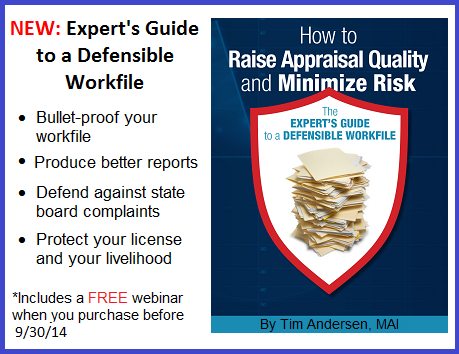 |
>> See Past News Editions >> Click to Print > NEW: State Appraisal Board “Insurance”-Bulletproof Your Workfile The new 2014 Expert’s Guide to a Defensible Workfile shows you how to “bulletproof” your workfile and protect your appraisal license and livelihood. Produce better reports: Click here to learn more. >Want to be a better FHA Appraiser? The FHA Checklist and eBook keeps you up-to-date on FHA requirements, helps you be more efficient on FHA Inspections and keeps you off their “do not use” list. Click here to learn more. |
Adjustments- Your Opinion Doesn’t Count
By Richard Hagar, SRA
Regulations state that appraisal adjustments cannot be based upon an appraiser’s opinion. According to federal and state law, adjustments must be based on support and evidence- proof if you will, and an appraiser’s opinion is not considered to be “support.” Many appraisers have failed to support their adjustments and as a result have had their licenses revoked, penalties assessed and lawsuits lost, all because the they failed to understand a single but important requirement.
Think about your appraisals. Are the adjustments based on your opinion or do you have proof of the adjustment in your workfile? If your workfiles are reviewed by the state or as part of an investigation or lawsuit, would you have “the right stuff” or fail the test?
When I first got into the appraisal business, the person training me handed me a sheet of paper that listed all of the adjustments I was going to need to complete an appraisal. I bet this sounds familiar to many appraisers. I was also a real estate agent specializing in selling new homes, so I knew what builders were charging for add-ons like a kitchen upgrade, extra bathroom or garage. So between what I was told to use and what I knew builders were charging: “Of course I know what the adjustment should be- $2,500 for a bedroom, $2,500 for a bathroom, $3,500 for a garage and $500 for a fireplace. We are all in agreement…..right!?!”
Then one day I was appraising a multi-million dollar waterfront home and that trusty, crusty old “sheet of adjustments” just didn’t make sense. People would spend $20,000 for new carpet so a $2,500 adjustment for a bedroom wasn’t cutting it. Ends up that the person who trained me, along with that “sheet of adjustments” were worthless. My solution was to take a class on adjustments from the Appraisal Institute as well as reaching out and learning from good appraisers. What I learned was like a ray of sunshine from above. And the funny thing is that the Uniform Standards of Professional Appraisal Practice (USPAP) had laid out the requirements for years…..I just didn’t get it….not at first.
USPAP
Scope of Work: “Credible assignment results require support by relevant evidence and logic.” Standards Rule 1-4 (a): When a sales comparison approach is applicable, an appraiser must analyze such comparable sales data as are available to indicate a value conclusion.
(story continues below)

(story continues)
Note the important words “support,” “evidence,” “logic” and “indicate.” Appraisers are not allowed to “feel” the adjustment or have just an “opinion” of what the adjustment is. Appraisers must have market data that indicates, supports and proves what an adjustment should be. Adjustments must, let me repeat, MUST be based upon the market’s reaction, not an appraiser’s opinion.
Here are some quotes from state disciplinary actions against appraisers:
• C. S. – “Failed to support site adjustments.”
• P. P. – “Failed to support lump sum adjustments.”
• J. C. – “Failed to disclose methodologies used to arrive at adjustments made to the comparables.”
Just because an adjustment for a bedroom is $5,000 in one neighborhood, does not mean the adjustment is the same for every neighborhood, city, price range, quality or style of house. For a $50 million home I guarantee that $5,000 won’t cover the adjustment due to the lack of a second dishwasher in the kitchen, much less a missing bedroom. When market prices are depressed, the condition of a house is important and can mean tens of thousands of dollars. However, in our fast-paced, shortage-driven Seattle market, even “fixer-upper” homes (C6) are selling for almost the same as an “average” condition home (C3 or 4). Markets change, adjustments change and different segments of markets react differently to all sorts of stimuli. So an appraiser sitting back in his chair, scratching his belly and stating that “in my opinion the adjustment for square footage should be X” is absolutely wrong and likely to get into trouble.
(story continues below)

(story continues)
When I teach the class The Art of Determining Appraisal Adjustments the first thing that happens to appraisers is that their eyes grow wide and filled with a look of horror. Then they blurt out: “Oh my God, how am I supposed to prove adjustments?” or “I’m not going to do that for a lousy AMC fee!” I can’t see it but I’m sure the same thing happens to appraisers at home during (the Working RE/OREP on demand webinar) How to Support and Prove Your Adjustments! Relax, once you understand the various methodologies that are available it’s not that difficult or time-consuming (depending on the property of course). Methodologies Each approach to value (comparison, cost, income) requires adjustments. Appraisers are being paid to analyze the market, so an understanding of the various methodologies is part of the job. No single methodology is 100 percent correct all of the time in every area and for every property (commercial or residential). The trick is to understand the methodologies. As the appraiser gathers data, adjustments often become evident if you know what to look for and how to utilize the various methods. Here are just a few of the methods available to appraisers:
• Matched Paired Analysis;
• Single Line (Linear) Regression Analysis;
• Multiple Regression Analysis;
• Grouped Analysis;
• Allocation;
• Income Approach;
• Cost Approach;
• Depreciated Cost;
• and my favorite – Hagar’s Percentage of Use Calculation.
All of the arguments out there on the blogs as to which method is best are a waste of time. The methods you use depend on the property type, the amount of data that’s available, your knowledge and what you have agreed to within your scope of work. Understand that if a review appraiser were to pick up your workfile, they must be able to recreate your appraisal, right down to the adjustments and value conclusion. And that is the standard used in court and by state licensing agencies; are your files ready for that level of investigation?
Bottom Line
If you are making adjustments based on what your were told or “what is common for my area” you are doing the job incorrectly. Your appraisals are a failure and you risk being sanctioned or worse. With all of the complaints, state investigations and “buy-back” lawsuits out there, you can’t afford to have such basic failures in your work. Failure is a very expensive way of doing business. The cheaper, better method is to get educated. Take good classes/webinars and step up your game. Your appraisals will be more accurate, better than the other guy and worth more, so you likely will be able to charge more. It worked for me and American Home Appraisals, it will work for you.
I’m trying to keep you safe out there!
Working RE/OREP Webinar Series
Watch at Your Own Convenience
How to Support and Prove Your Adjustments
Available for Immediate Download
Richard Hagar, SRA shows you the most common appraisal pitfalls when determining adjustments and how to provide the proper support, analysis and documentation for adjustments in your appraisal report and workfile. Stay trouble free with Fannie Mae and others! This course will help you understand and utilize quick and simple methods for proving adjustments and help you avoid problems, blacklisting and legal actions. Sign Up Now!
November Live Webinar – FREE*
Fighting Appraisal Board Complaints: An Expert’s Advice
Date: November 4, 10 – 11 a.m. PST
Bob Keith, MAA, IFA, Former Executive Director and Compliance Coordinator for the Oregon Appraisal Board, gives you a rare expert’s insight into the complaint process, showing you how to avoid the most common pitfalls and mistakes appraisers make when dealing with their state board. Learn what steps to take to protect yourself and what is and isn’t in your own best interests. Keith takes you through a step-by-step process on how to interact with your state board to achieve the best results possible. Read More.
*FREE to OREP Members/ Affiliates / WRE Subscribers
Email isaac@orep.org for your invitation.
All Others ONLY $29 – Read More / Register Now
>Seating is limited, Reserve your seat today!
We’re always listening: Send your story submission/idea to the Editor: dbrauner@orep.org.


by Scotty D
If your “opinion” does not count for adjustments, how can your “opinion” count for “your opinion of market value?”
-by Jim C.
This business is in rapid decline. There are no more trainees for a reason. Technology is fazing much of it out quickly. The state can do whatever it wants if a complaint is filed against you.
-